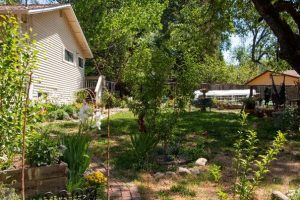Helping Your Garden Grow Like Weeds
Nature has a long lead on us regarding how to grow plants. First plants on land appeared about 400 million years ago. Seed bearing plants, which form the basis of our flower and vegetable gardens, only began to appear 20 million years ago. No matter how you cut it, with that kind of lead, we ought to pay more attention to how plants grow naturally.
If you think digging is the answer, look at how many seasons it takes to regrow an area where there has been a landslide. Another question: why do I always have tons of miner’s lettuce in the spring but my butter lettuce struggles? Questions like these started me thinking about no dig gardening.
The basics of plant growth have not changed since the beginning; light, water, air and nutrients. You can grow plants in nutrient rich water, so soil—for many plants—becomes totally unnecessary.
In its most basic form, no dig gardening is about replicating the natural process occurring in the area in which you live. Forests, grasslands, even deserts, are all part of a huge cycle. Plants sprout where conditions are right, grow, die and then decay and are returned to the soil to form the base for the next generation of plants. Digging or plowing to form the bed for your crop works pretty well until the topsoil is exhausted. Then you get a dust bowl
It is also like mining for weed seeds. Trust me, you will strike it rich! Seeds can survive thousands of years in the dark underground. Digging brings them to the light. After all that waiting, they will outdo themselves irritating you, and overwhelming your carrots.
The other problem with digging is that it disturbs the mycorrhizae. In the last half of the 20th century, science discovered the symbiotic relationship between fungus and the plants we grow. No dig gardening protects this natural symbiotic relationship as well as encouraging earthworm activity, which is a giant step toward a healthy garden ecosystem.
Nature keeps the weeds down with mulch. Leaves fall, forming a natural mulch layer and then decompose, fertilizing the ground. Over the eons, a forest can form feet of the richest soil you can imagine. Leaves are natural mulch. If you are to be successful at no dig gardening, you have to mulch. You can start your no till garden with 5 to 7 inches of good weed free compost placed on top of wet cardboard.
Nature naturally forms compost beds, then plants it without ever digging it up. No dig gardening follows this pattern. One warning, though, if you really want to get into no dig gardening, you will need to get good at composting. There is no such thing as garden waste, all of it is precious compost material. If you plant a no dig garden year after year without feeding the soil, your yields will drop dramatically. You need to add 2-3 inches of good compost to the surface of your garden every year. It will act as a mulch to keep the weeds down and conserve water, as well as feeding the soil much needed nutrients.
Give no dig gardening a try. Your back will thank you!
Jim Bliss is a University of California Cooperative Extension Master Gardener of Tuolumne County.

